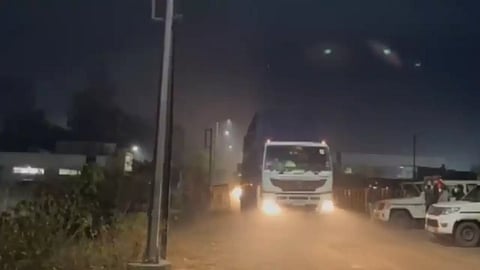
- Home
- Live Blog
- Breaking News
- Top Headlines
- Cities
- NE News
- Sentinel Media
- Sports
- Education
- Jobs

BHOPAL: In a high-security operation, 12 containers of hazardous waste from the 1984 Union Carbide disaster are being transported from Bhopal to Pithampur. The toxic waste is being moved through a 250-kilometer-long green corridor, accompanied by ambulances, police vehicles, and fire brigades. A team of 50 police personnel is escorting the convoy, with an Additional Superintendent of Police overseeing the operation that began late Wednesday evening.
The 337 metric tonnes of toxic waste, stored at the abandoned Union Carbide factory in Bhopal, were loaded into 12 leak-proof and fire-resistant containers. Each container carries approximately 30 tonnes of waste, securely packed in jumbo HDPE bags to prevent chemical reactions. In preparation for the transfer, a 200-meter radius around the factory was sealed, and 200 workers, equipped with PPE kits, worked in short shifts to ensure safety during loading.
Pithampur Disposal Plant and Controversy
The waste is destined for the Pithampur waste disposal plant, the only state-of-the-art incineration facility in Madhya Pradesh, operated by Ramky Enviro Engineers under Central Pollution Control Board (CPCB) guidelines. The plant will incinerate the waste on a wooden platform built 25 feet above ground, following strict scientific protocols. Tests will determine the appropriate conditions for disposal.
At a rate of 90 kg per hour, the process will take 153 days to complete; an increased speed of 270 kg per hour could reduce the timeline to 51 days. Air quality and soil contamination are being closely monitored to prevent environmental impact.
However, the move has sparked significant resistance from civil society in Pithampur. More than 10 organizations have called for a shutdown, demanding the waste be sent abroad instead. A petition filed by doctors from Indore’s Mahatma Gandhi Memorial Hospital Alumni Association has also raised concerns about the disposal process, citing the lack of adequate trials.
Waste Composition and Historical Context
The hazardous waste includes five types of materials such as soil, pesticide residues, and chemical remnants from manufacturing. The disposal operation comes nearly four decades after the Bhopal Gas Tragedy, one of the world’s worst industrial disasters, which claimed over 5,000 lives due to a methyl isocyanate gas leak.
ALSO READ: PM Modi Meets Diljit Dosanjh, Hails Him As A Blend Of Talent And Tradition
ALSO WATCH: